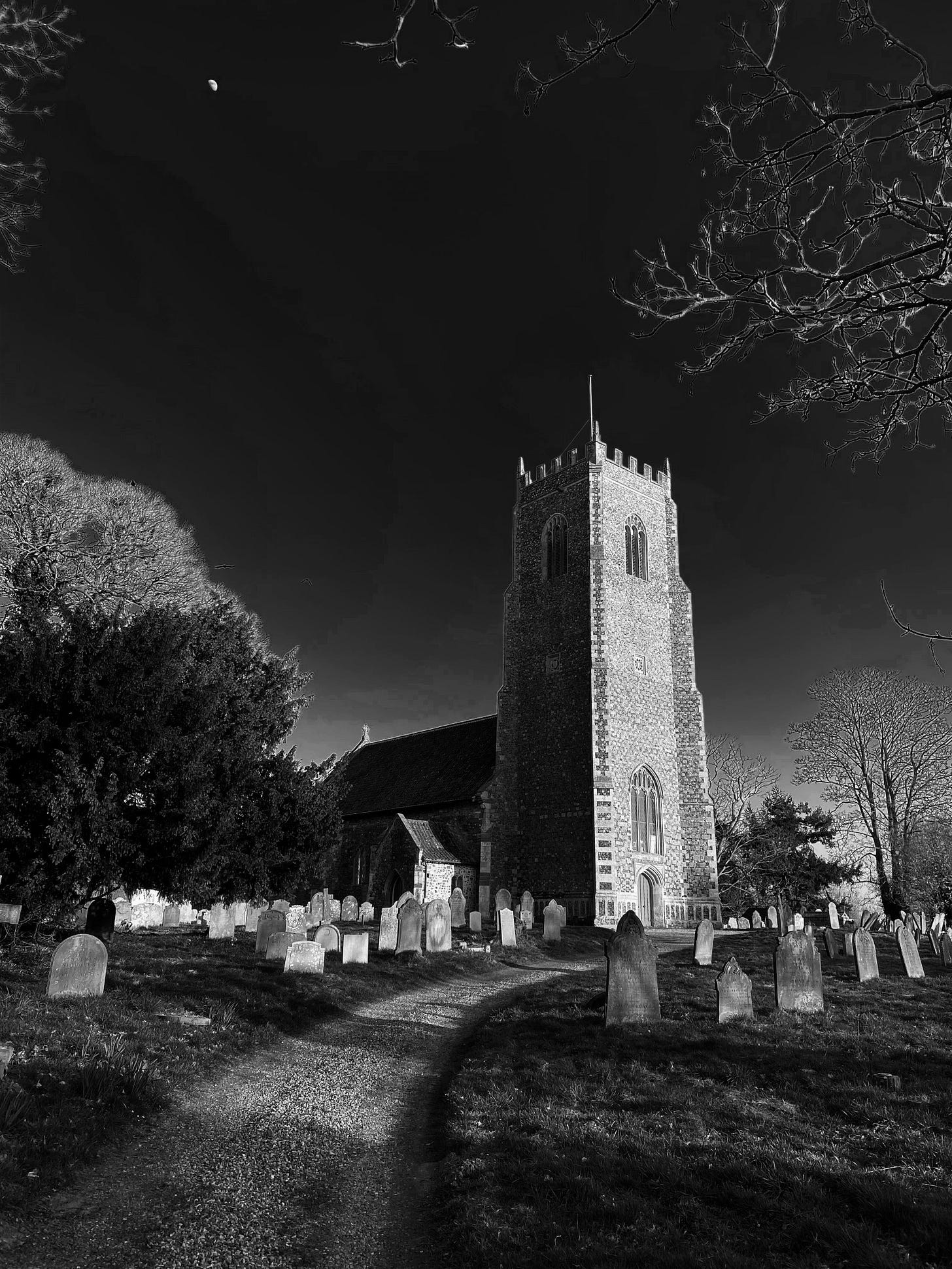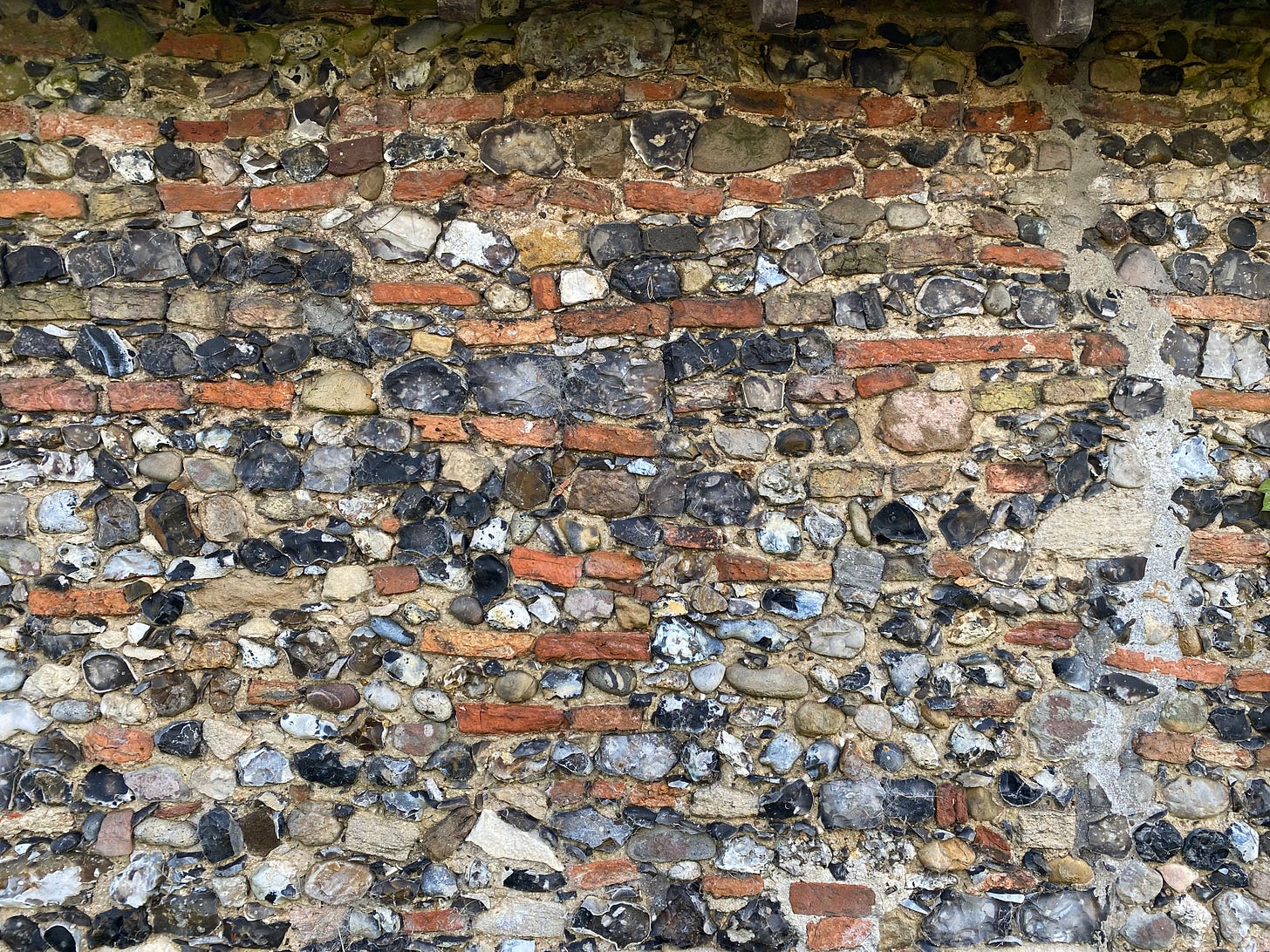Earlier this month I was staying in northeast Suffolk and took the opportunity to visit an intriguing site I recently read about in Current Archaeology: the church of St John the Baptist, Reedham, which is located on the Norfolk side of the River Yare (the boundaries have shifted since, but the Yare used to mark the border between Norfolk and Suffolk), a few miles west of the impressive Roman ruins at Burgh Castle. Reedham church is noteworthy for its extreme levels of reuse of Roman spolia (re-purposed building materials), suggesting that a significant Roman structure was located close to the church; and Reedham was the subject of recent archaeological investigations which you can read about in full here, in a paper co-authored by Mike Fulford and seven other archaeologists. It is now clear that Reedham is one of East Anglia’s and Norfolk’s most significant Roman sites, and archaeologists have uncovered evidence not only for a possible Roman Pharos or beacon but also for a very early church that may be linked to the apostle of the East Angles, St Felix of Burgundy (d. 647).
In recent years the Roman origins of many of southern England’s churches have come into sharper focus – consider, for instance, the well-publicised excavations of St Mary’s Church, Stoke Mandeville, which uncovered the remains of an Anglo-Saxon tower beneath the medieval church that was in fact of Roman origin, and may have begun life as some sort of mausoleum. In the 7th century, still standing Roman buildings throughout southern England were in the process of being turned into churches – not just because they were available buildings of brick and stone, but also because their association with Rome was something the missionaries sent by the Pope themselves desired. A key part of the appeal of Christianity to Anglo-Saxon rulers was its perceived Romanitas. Thus we find Kent littered with Roman buildings repurposed as churches – at Lullingstone, where a circular Roman mausoleum was once a church; at Stone near Faversham, where the ruins of a Roman temple converted into a chapel still stand; and of course in Canterbury, where the churches of St Martin (still standing) and St Pancras (a ruin that is now part of St Augustine’s Abbey) bear witness to the extensive re-use of brick from Roman buildings in the late 6th century. Indeed, Fulford et al. make an explicit comparison between Reedham and the Canterbury churches.
The church that is currently standing at Reedham is mostly of around 1300, but the materials it is made of are far older – and, as so often with medieval churches, the later church simply reused the materials of earlier churches on the site, preserving a direct link with the Anglo-Saxon past. The recent excavations, however, revealed something much more exciting than just a lot of Roman brick, stone and tile – they uncovered a curved Roman wall running directly under the church, suggesting that it was built right on top of a circular Roman building. Reedham’s location on the navigable Yare would make it a suitable site for a Pharos or beacon, and the archaeologists seem to have demonstrated the likely military nature of the original installation by tracing the composition of its stone to West Norfolk – a long journey for materials that would make sense only in the context of a centralised state-sponsored construction project of the kind undertaken by the Roman army or navy. The installation at Reedham should therefore be seen as an integral part of the ‘Saxon Shore’ forts that protected southern and eastern Britain from the third century onwards from attacks by Germanic pirates.
But the discoveries did not end here – the archaeologists also uncovered evidence of a rectangular building beneath the current church but misaligned with it, suggesting an earlier medieval church perhaps dating back to the 7th century. Intriguingly, the 12th-century Liber Eliensis claims that St Felix established a church at a place called Redham, and as Fulford et al. point out, the idea that Felix could have built a church at Reedham is certainly plausible. The site of Felix’s see at Dommoc remains uncertain – with Dunwich the traditional site, but many historians preferring the Roman shore fort at Walton Castle (both potentially sites, inconveniently, have now been swallowed up by the sea). We know that early missionaries in the east of England liked to make use of the protective walls of former Roman towns and forts – consider the examples of St Cedd at London (where the original St Paul’s was built within the walls of Londinium) and Bradwell-on-Sea where Cedd’s original chapel built within the walls of the Roman fort of Othona still survives. Another case is Burgh Castle, which according to tradition is the place called Cnoberesburgh where St Fursey founded his monastery (although archaeological evidence of Christian settlement at Burgh Castle remains elusive).
The archaeological investigations at Reedham have revealed that a Pharos or beacon was probably protected by an enclosing wall, which would have made the site an attractive one to Felix or Fursey – not only were there building materials for a church, but there was also some protection. The walls of the church at Reedham are full of Roman bricks and tiles, including a large brick arch on the north side of the nave, which Fulford et al. suggest may once have been a 13th-century portico attached to a much earlier church. At an even later date, Roman stones were reused in the church’s tower – their distinctively Roman dimensions (squat rectangles) make them instantly recognisable. As the archaeologists note, reusing Roman materials was not easy, and it must have been a very deliberate and purposeful decision – after all, most of the earliest churches were built of much more ephemeral materials. The suggestion is not that Reedham actually was Dommoc, but that Reedham was another site that played in Felix’s wider mission – although, given the absence of archaeological evidence for Fursey’s monastery at Burgh Castle and Reedham’s proximity to Burgh, there may be a case to be made that Reedham is actually a better candidate for Cnoberesburgh. After all, the Liber Eliensis may have associated Reedham with Felix because it was known to be made out of Roman materials, indicating its antiquity, rather than because some otherwise unknown historical tradition linked it directly to Felix. The medieval monks of Ely may have been engaging in supposition as much as we are.
So was Reedham one of the earliest churches founded in East Anglia, and perhaps the earliest that survives in any form? As I left Reedham I suddenly realised the date – it was 8 March, and almost unbelievably I had forgotten that it was St Felix’s Day. The coincidence seemed almost supernatural. Perhaps St Felix was trying to tell me something…?








Do you know Richard Coates' article on 'Domnoc' and Felixstowe (in Coates & Breeze, 'Celtic Voices, English Places' (2000), pp. 234–40)? Proposes an etymology in Old Irish domnach 'church', rules out any connection with Dunwich, and suggests that 'Domnoc' is an earlier name of Felixstowe. Recommended reading.
I love these evidences of continuity at church sites, from Roman through Saxon and medieval times...Sometimes there even seems to be evidence of pre-Roman religious or ritual practice on the same site. Do you know the church at Daglingworth, Gloucestershire? It has partly Saxon fabric, Saxon sculptures were discovered there (hidden at some point inside the chancel arch), and there is a window that is cut in an old Roman-era stone bearing an inscription saying that Junia made a vow to the "genius loci." Carvings of genii cucullati & mother goddesses found in the vicinity....many layers!